
En ce 29 octobre, 2000, fichier photo, le booster Soyouz est transporté vers la rampe de lancement du cosmodrome de Baïkonour au Kazakstan. Deux jours plus tard, L'astronaute américain Bill Shepherd, et les cosmonautes russes Sergueï Krikalyov et Yuri Gidzenko ont décollé pour devenir les premiers résidents de la Station spatiale internationale. (AP Photo/Mikhail Metzel, Déposer)
La Station spatiale internationale était à l'étroit, humide, trois pièces chétives lorsque le premier équipage a emménagé. Vingt ans et 241 visiteurs plus tard, le complexe dispose d'une tour de guet, trois toilettes, six compartiments de couchage et 12 chambres, selon la façon dont vous comptez.
Lundi marque deux décennies d'un flux constant de personnes qui y vivent.
Des astronautes de 19 pays ont flotté à travers les écoutilles de la station spatiale, y compris de nombreux visiteurs réguliers qui sont arrivés sur des navettes pour des travaux de construction à court terme, et plusieurs touristes qui ont payé leur propre trajet.
Le premier équipage, l'Américain Bill Shepherd et les Russes Sergei Krikalev et Yuri Gidzenko, a décollé du Kazakhstan le 31 octobre. 2000. Deux jours plus tard, ils ont ouvert les portes de la station spatiale, joignant leurs mains dans l'unité.
Berger, un ancien Navy SEAL qui a servi comme commandant de station, l'a comparé à vivre sur un navire en mer. Les trois ont passé la plupart de leur temps à cajoler l'équipement pour travailler; les systèmes hésitants rendaient l'endroit trop chaud. Les conditions étaient primitives, par rapport à maintenant.
Les installations et les réparations ont pris des heures à la nouvelle station spatiale, contre des minutes au sol, Krikalev a rappelé.
"Chaque jour semblait avoir son lot de défis, " a déclaré Shepherd lors d'une récente table ronde de la NASA avec ses coéquipiers.
La station spatiale s'est depuis transformée en un complexe presque aussi long qu'un terrain de football, avec huit milles (13 kilomètres) de câblage électrique, un acre de panneaux solaires et trois laboratoires de haute technologie.
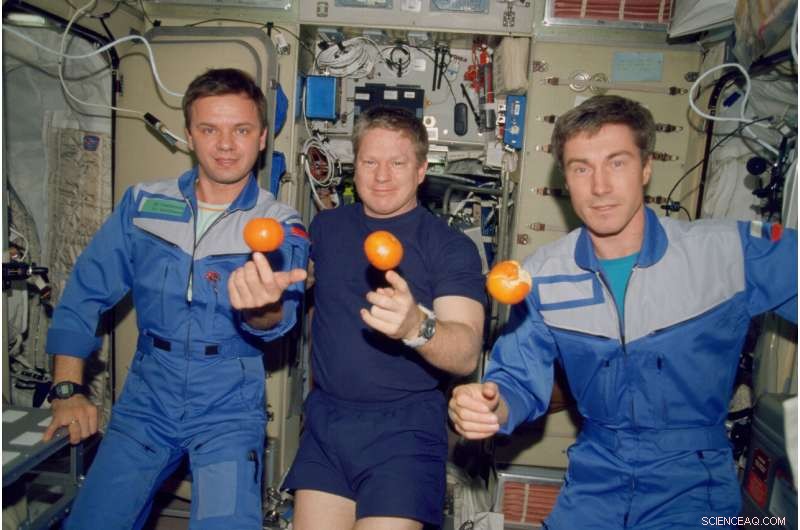
Sur cette photo fournie par la NASA, les membres d'équipage de l'Expédition 1 posent avec des oranges fraîches à bord du module de service Zvezda de la Station spatiale internationale en orbite autour de la Terre le 4 décembre 2000. Sur la photo, de gauche, sont le cosmonaute Yuri P. Gidzenko, commandant de Soyouz ; l'astronaute Bill Shepherd, commandant de mission; et le cosmonaute Sergueï K. Krikalev, mécanicien de bord. (NASA via AP)
"C'est 500 tonnes de trucs qui zooment dans l'espace, dont la plupart ne se sont jamais touchés jusqu'à ce qu'il monte là-haut et s'envole, " Shepherd a déclaré à l'Associated Press. "Et tout a fonctionné pendant 20 ans sans presque aucun gros problème."
"C'est un véritable témoignage de ce qui peut être fait dans ce genre de programmes, " il a dit.
Berger, 71, est depuis longtemps à la retraite de la NASA et vit à Virginia Beach, Virginie. Krikalev, 62, et Gidzenko, 58, ont grimpé dans les rangs spatiaux russes. Tous deux ont participé au lancement mi-octobre du 64e équipage.
La première chose que les trois ont fait une fois arrivés à la station spatiale assombrie le 2 novembre, 2000, était d'allumer les lumières, que Krikalev a rappelé comme "très mémorable". Ensuite, ils ont chauffé l'eau pour les boissons chaudes et activé les toilettes isolées.
"Maintenant nous pouvons vivre, " Gidzenko se souvient avoir dit Shepherd. " Nous avons des lumières, nous avons de l'eau chaude et nous avons des toilettes."

En ce 31 octobre 2000, image de fichier à partir d'une vidéo fournie par la NASA, un nuage de fumée entoure la fusée Soyouz quelques secondes avant le décollage du cosmodrome de Baïkonour au Kazakstan, transportant les premiers résidents de la Station spatiale internationale. Deux jours plus tard, L'astronaute américain Bill Shepherd, et les cosmonautes russes Sergueï Krikalev, et Yuri Gidzenko sont arrivés à la station spatiale. (NASA via AP, Déposer)
L'équipage a appelé leur nouvelle maison Alpha, mais le nom n'a pas collé.
Bien qu'ayant ouvert la voie, les trois n'ont pas eu d'appels rapprochés pendant leurs près de cinq mois là-bas, Berger a dit, and so far the station has held up relatively well.
NASA's top concern nowadays is the growing threat from space junk. This year, the orbiting lab has had to dodge debris three times.
As for station amenities, astronauts now have near-continuous communication with flight controllers and even an internet phone for personal use. The first crew had sporadic radio contact with the ground; communication blackouts could last hours.
While the three astronauts got along fine, tension sometimes bubbled up between them and the two Mission Controls, in Houston and outside Moscow. Shepherd got so frustrated with the "conflicting marching orders" that he insisted they come up with a single plan.

In this Oct. 31, 2000, photo provided by NASA, Expedition 1 crew members, from top, Sergei K. Krikalev, Bill Shepherd and Yuri P. Gidzenko pose for final photos prior to their launch aboard a Soyuz rocket to the International Space Station from the Baikonur Cosmodrome in Kazakhstan. Deux jours plus tard, they swung open the space station doors, clasping their hands in unity. Thus began 20 years of international cooperation and a steady stream of crew from around the world. (NASA via AP)
"I've got to say, that was my happiest day in space, " he said during the panel discussion.
With its first piece launched in 1998, the International Space Station already has logged 22 years in orbit. NASA and its partners contend it easily has several years of usefulness left 260 miles (400 kilometers) up.
The Mir station—home to Krikalev and Gidzenko in the late 1980s and 1990s—operated for 15 years before being guided to a fiery reentry over the Pacific in 2001. Russia's earlier stations and America's 1970s Skylab had much shorter life spans, as did China's much more recent orbital outposts.
Astronauts spend most of their six-month stints these days keeping the space station running and performing science experiments. A few have even spent close to a year up there on a single flight, serving as medical guinea pigs. Shepherd and his crew, par contre, barely had time for a handful of experiments.

This photo provided by NASA shows a Progress supply ship that arrived on Nov. 18, 2000 to link up to the International Space Station, bringing Expedition 1 commander Bill Shepherd, pilot Yuri P. Gidzenko and flight engineer Sergei K. Krikalev two tons of food, Vêtements, hardware and holiday gifts from their families. (NASA via AP)
The first couple weeks were so hectic—"just working and working and working, " according to Gidzenko—that they didn't shave for days. It took awhile just to find the razors.
Even back then, the crew's favorite pastime was gazing down at Earth. It takes a mere 90 minutes for the station to circle the world, allowing astronauts to soak in a staggering 16 sunrises and 16 sunsets each day.
The current residents—one American and two Russians, just like the original crew—plan to celebrate Monday's milestone by sharing a special dinner, enjoying the views of Earth and remembering all the crews who came before them, especially the first.
But it won't be a day off:"Probably we'll be celebrating this day by hard work, " Sergei Kud-Sverchkov said Friday from orbit.
One of the best outcomes of 20 years of continuous space habitation, according to Shepherd, is astronaut diversity.

Sur cette photo fournie par la NASA, Expedition 1 flight engineer Sergei K. Krikalev works in the Zvezda Service Module, with his feet anchored in a tunnel hatchway, aboard the International Space Station on Dec. 6, 2000. The space station was cramped and humid with just three rooms when the first crew moved in. Conditions were primitive, compared with now, and the three spent most of their time coaxing equipment to work. In the past twenty years, the space station has morphed into a complex that's almost as long as a football field, with eight miles (13 kilometers) of electrical wiring and three high-tech labs. (NASA via AP)
While men still lead the pack, more crews include women. Two U.S. women have served as space station skipper. Commanders typically are American or Russian, but have also come from Belgium, Allemagne, Italie, Canada and Japan. While African-Americans have made short visits to the space station, the first Black resident is due to arrive in mid-November on SpaceX's second astronaut flight.
Massive undertakings like human Mars trips can benefit from the past two decades of international experience and cooperation, Shepherd said.
"If you look at the space station program today, it's a blueprint on how to do it. All those questions about how this should be organized and what it's going to look like, the big questions are already behind us, " he told the AP.
Russie, par exemple, kept station crews coming and going after NASA's Columbia disaster in 2003 and after the shuttles retired in 2011.

Sur cette photo fournie par la NASA, Expedition 1 mission commander Bill Shepherd works in a docking compartment aboard the International Space Station on Dec. 5, 2000. The International Space Station was a cramped, humid, puny three rooms when the first crew moved in. Twenty years and 241 residents later, the complex has a domed lookout, three toilets, six sleeping compartments and 10 rooms, depending on how you count. (NASA via AP)

This photo provided by NASA shows the new International Space Station after the crew of the Space Shuttle Endeavour captured the Zarya Control Module, la gauche, and mated it with the Unity Node, droit, inside the Shuttle's payload bay. This photo was taken after Endeavour undocked from the space station on Dec. 13, 1998, for the return to Earth. Almost two years later, the first crew—American Bill Shepherd and Russians Sergei Krikalev and Yuri Gidzenko—blasted off from Kazakhstan on Oct. 31, 2000, en route to the space station. Thus began 20 years of international cooperation and a steady stream of crew from around the world. (NASA via AP)
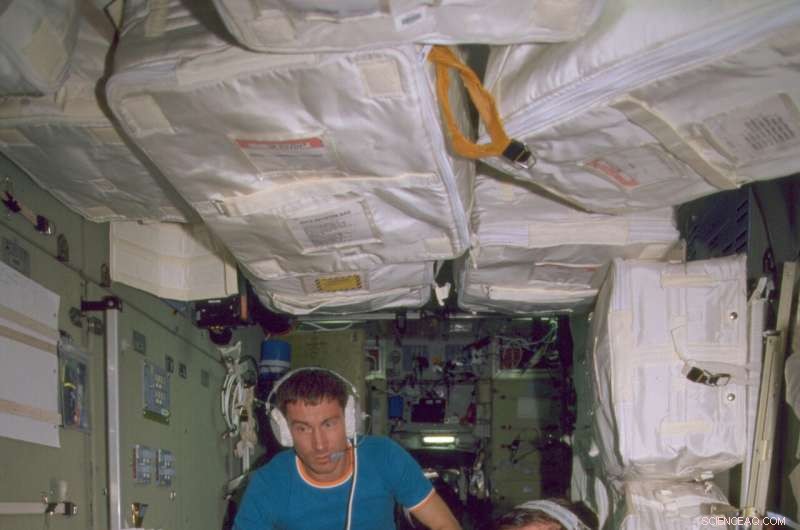
Sur cette photo fournie par la NASA, Expedition 1 crew members Sergei Krikalev, la gauche, and Yuri Gidzenko work in the Zvezda Service Module onboard the International Space Station on Nov. 8, 2000. The first crew, Russians Krikalev and Gidzenko along with American Bill Shepherd, spent most of their time coaxing equipment to work in the cramped and humid three-room space station. Twenty years and 241 residents later, the complex is almost as long as a football field, with six sleeping compartments, three toilets, a domed lookout and three high-tech labs. (NASA via AP)

This photo provided by NASA shows the International Space Station as seen from Space Shuttle Atlantis during mission STS-106, which delivered supplies and performed maintenance in September 2000. The first crew of the space station—American Bill Shepherd and Russians Sergei Krikalev and Yuri Gidzenko—arrived less than two months later. Thus began 20 years of international cooperation and a steady stream of crew from around the world. (NASA via AP)

This Oct. 20, 2000 photo made available by NASA shows the International Space Station after separation of the Space Shuttle Discovery. Backdropped against the blackness of space, the Z1 Truss structure and its antenna, as well as the new pressurized mating adapter (PMA-3), are visible in the foreground. (NASA via AP)
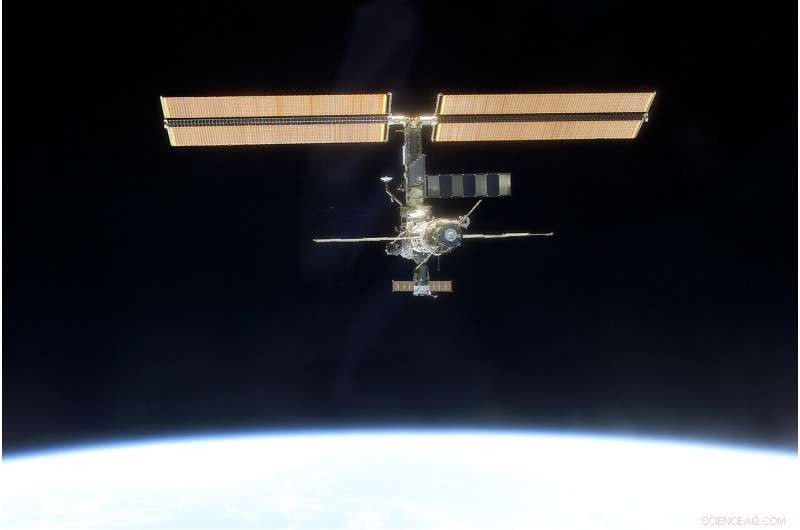
Sur cette photo fournie par la NASA, the International Space Station, backdropped against black space above Earth's horizon, is seen from the Space Shuttle Discovery on March 19, 2001, after a new crew comprised of cosmonaut Yury Usachev and astronauts James Voss and Susan Helms began several months aboard the station. In the early days of the station, it was a cramped and humid, with just three rooms. It's much larger now, with six sleeping compartments, three toilets, a domed lookout and three high-tech labs. (NASA via AP)

This photo provided by NASA shows the International Space Station as seen from Space Shuttle Endeavour as the two spacecraft begin their relative separation on Nov. 28, 2008. Twenty years after the first crew arrived at the space station, the spacecraft has hosted 241 residents and grown from three cramped and humid rooms to a complex almost as long as a football field, with six sleeping compartments, three toilets, a domed lookout and three high-tech labs. (NASA via AP)

This photo provided by NASA shows the International Space Station as seen from the Space Shuttle Atlantis after the station and shuttle began their post-undocking relative separation on May 23, 2010. Twenty years after the first crew arrived, the space station has hosted 241 residents and grown from three cramped and humid rooms to a complex almost as long as a football field, with six sleeping compartments, three toilets, a domed lookout and three high-tech labs. (NASA via AP)

Sur cette photo fournie par la NASA, backdropped against clouds over Earth, the International Space Station is seen from Space Shuttle Discovery as the two orbital spacecraft accomplish their relative separation on March 7, 2011. From the first crew to the most recent, the No. 1 pastime aboard the station is gazing down at Earth. It takes just 90 minutes to circle the world, allowing crews to soak in a staggering 16 sunrises and 16 sunsets every day. (NASA via AP)
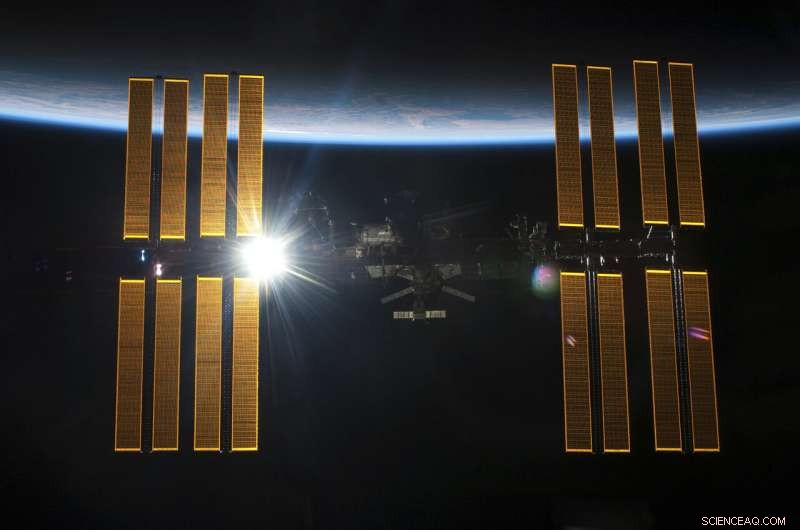
Dans cette image fournie par la NASA, the International Space Station is seen from the Space Shuttle Endeavour on May 29, 2011, after the station and shuttle began their post-undocking relative separation. It takes just 90 minutes for the space station to circle the world, allowing crews to see 16 sunrises and 16 sunsets every day. (NASA via AP)

Sur cette photo fournie par la NASA, the International Space Station is seen from the Space Shuttle Atlantis as the two spacecraft perform their relative separation on July 19, 2011. Above and to the right of the space station is the moon far in the distance. (NASA via AP)

In this photo provided by NASA/Roscosmos, the International Space Station floats above the Earth as seen from a Soyuz spacecraft after undocking on Oct. 4, 2018. NASA astronauts Andrew Feustel and Ricky Arnold and Roscosmos cosmonaut Oleg Artemyev executed a fly around of the orbiting laboratory to take pictures of the station before returning home after spending 197 days in space. Twenty years after the first crew arrived, the space station has hosted 241 residents. (NASA/Roscosmos via AP)
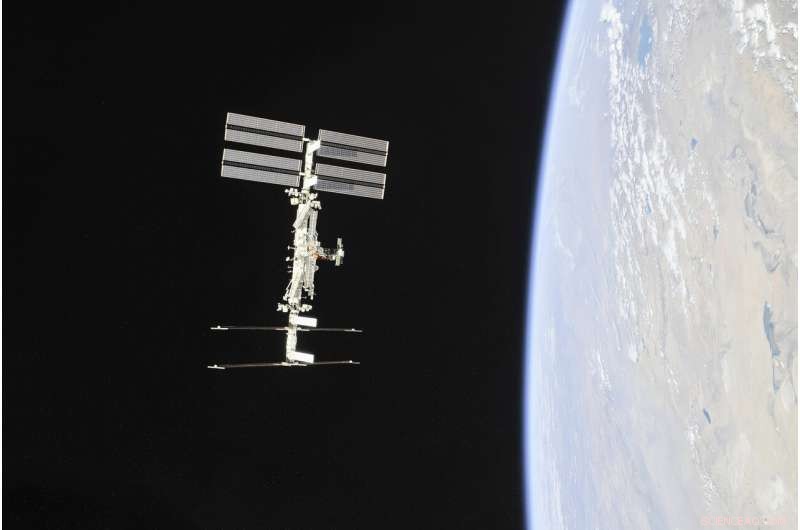
In this photo provided by NASA/Roscosmos, the International Space Station continues its orbit around the Earth as seen from a Soyuz spacecraft departing with NASA astronauts Andrew Feustel and Ricky Arnold and Roscosmos cosmonaut Oleg Artemyev, who had spent 197 days in space. From the first crew to the most recent, the No. 1 pastime aboard the station is gazing down at Earth. It takes just 90 minutes to circle the world, allowing crews to soak in a staggering 16 sunrises and 16 sunsets every day. (NASA/Roscosmos via AP)
When Shepherd and his crewmates returned to Earth aboard shuttle Discovery after nearly five months, his main objective had been accomplished.
"Our crew showed that we can work together, " il a dit.
© 2020 La Presse Associée. Tous les droits sont réservés. Ce matériel ne peut pas être publié, diffuser, réécrit ou redistribué sans autorisation.